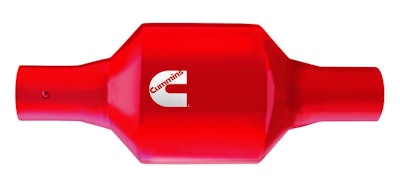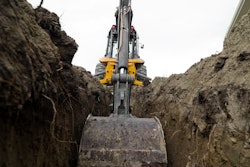 The 4-cylinder QSB3.3 and QSB4.5 engines from Cummins offers a simplified Tier 4 installation across a broad 75- to 160-hp (56-119 kW) power range
The 4-cylinder QSB3.3 and QSB4.5 engines from Cummins offers a simplified Tier 4 installation across a broad 75- to 160-hp (56-119 kW) power rangeCummins Inc. revealed on April 19 at the Bauma show the latest generation of its 4-cylinder QSB3.3 and QSB4.5 engines offering a simplified Tier 4 installation across a broad 75- to 160-hp (56-119 kW) power range.
With an air-intake-to-exhaust aftertreatment system specifically designed for highly flexible machine integration, the 3.3-liter and 4.5-liter QSB engines will lead the way for compact equipment to more easily meet low-emissions regulations in 2012, Cummins says.
The 4-cylinder QSB engines operate as integrated Tier 4 emissions systems with Cummins Compact Catalyst exhaust aftertreatment, shown for the first time at Bauma.
Introduced for EPA Tier 4 Interim and EU Stage IIIB off-highway applications, the catalyst removes particulate matter (PM) by simple, flow through passive oxidation. With a smaller size than other types of aftertreatment, the Cummins Compact Catalyst can be installed in space-constrained equipment with the added flexibility of mounting separately from the exhaust muffler, or as part of a combined catalyst-and-muffler unit.
With no impact on equipment operation, the catalyst offers a robust and maintenance-free “fit and forget” solution, ideally suited for the rental-equipment market, according to the manufacturer.
Compared with Tier 3 applications, the QSB3.3 and QSB4.5 engines can achieve up to 5 percent improved fuel efficiency for Tier 4, depending on duty cycle.
Cleaner, more fuel-efficient combustion is achieved with a cooled Exhaust Gas Recirculation (EGR) system to reduce Oxides of Nitrogen (NOx) emissions. Extensively proven on Cummins 6-cylinder engines, the EGR system is scaled down for the 4-cylinder QSB configuration and driven by a variable-flow turbocharger. Using a simple variable turbine mechanism, the turbo improves boost across a wider engine speed than a wastegate turbo and avoids the complexity of dual turbochargers.
“By focusing on design simplicity, the 4-cylinder QSB engines reflect the need to maximize installation flexibility for Tier 4 compact equipment,” said Hugh Foden, executive director for Cummins Off-Highway Business in a press release.
“The Tier 3 QSB3.3 and QSB4.5 have earned an enviable reputation for durability and power productivity,” Foden continued. “Now, with the Cummins Compact Catalyst and upgraded performance systems, we are able to achieve low emissions without compromising the ability of these engines to perform at the highest load factors or in the toughest applications where they excel today.”
Equipment manufacturers looking to power a wide range of machines will benefit from Tier 4 installation commonality provided by the 4-cylinder QSB engines. The QSB3.3 extends across the 75- to 110-hp (56-82 kW) range, while the QSB4.5 extends from 110 hp to 160 hp (82-119 kW). For ratings up to 173 hp (129 kW), the larger 6-cylinder QSB6.7 engine will also be available with the Cummins Compact Catalyst.
The engines retain the impressive peak torque characteristics of the previous Tier 3 versions, with 306 lb-ft (415 N•m) peak torque available for the top-rated Tier 4 Interim QSB3.3 and 466 lb-ft (632 N•m) for the top-rated Tier 4 Interim QSB4.5.
Cummins Compact Catalyst
The Cummins Compact Catalyst represents the latest evolution of Diesel Oxidation Catalyst (DOC) aftertreatment, manufactured by Cummins Emission Solutions for over 15 years. The maintenance-free catalyst provides the installation simplicity needed for Tier 4 Interim and Stage IIIB engines below 174 hp (130 kW).
The Cummins Compact Catalyst achieves efficient PM reduction with a catalytic coating and substrate uniquely tailored to the QSB3.3 and QSB4.5 engines. By passively oxidizing PM from the exhaust stream with the simplicity of a small flow-through catalyst, Cummins is able to achieve Tier 4 emissions levels without compromising engine transient response or reliability.
Building On Proven Platforms
The Tier 4 Interim QSB3.3 and QSB4.5 engines build on the proven success of their Tier 3 predecessors by retaining the same displacement and base engine platform that has established an enviable reputation for durability even in the toughest applications.
The QSB3.3 and QSB4.5 engines were 4-cylinder pioneers in the use of a High Pressure Common Rail (HPCR) fuel system with advanced electronic management. This early advantage and experience at Tier 3 now pays dividends for the Tier 4 engine with surprisingly few engine changes needed to achieve low emissions.
The previous wastegate turbocharger is upgraded to a more efficient variable flow turbocharger to drive the EGR system and optimize boost across a wider engine speed.
The variable flow design ensures a simplicity and reliability appropriate for 4-cylinder engines. At low engine speed, the exhaust gas flow is directed to increase boost pressure – acting like a small turbocharger. At high engine speed, the flow is directed to retain the most efficient boost level – acting like a larger turbocharger.
Engine management capabilities of the QSB3.3 and QSB4.5 are upgraded to the latest CM2250 Electronic Control Module (ECM), sharing a common electronic architecture with more powerful Cummins Tier 4 engines. The control module provides three times faster processing and double the memory compared with the Tier 3 module.
The CM2250 module controls a performance-enhanced HPCR fuel system with fast power delivery and low-noise operation. The module also provides a seamless electronic interface to other systems on the equipment.
Engine cooling for the QSB3.3 and QSB4.5 incorporates a stronger drive fan system with auto-tensioning capability. Together with increased water pump flow rates, this will further enhance reliability and help mitigate demands on equipment cooling.
Direct Flow Air Intake
The QSB3.3 and QSB4.5 engines are integrated with the new Direct Flow air cleaner from Cummins Filtration, specifically developed to provide more performance in less space for Tier 4 applications.
Increased dust-holding capacity enables the Direct Flow technology to reduce air cleaner installation space claim compared with conventional cylindrical air cleaners, while achieving equal or better filtration performance. This is achieved by the innovative “V-Block” rectangular configuration of the Direct Flow, which optimizes space normally wasted in the inner diameter of round air filter elements.
The Direct Flow housing features an integral sensor for monitoring temperature and pressure to ensure that optimum airflow is delivered to the engine during all operating conditions. The housing is available with an optional precleaner cover that is able to remove up to 95 percent of particles before they reach the filter, offering significant benefits for high-dust environments. With enhanced filtration efficiency, Direct Flow offers the opportunity to extend filter service intervals and reduce operating costs.










